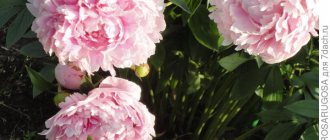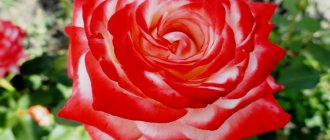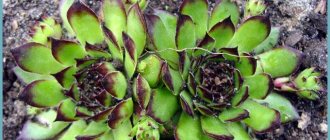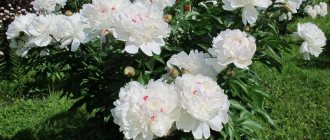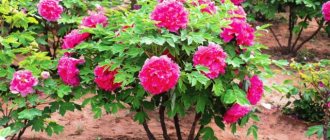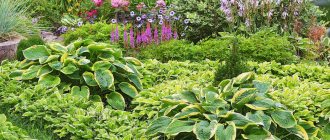Bartzell's peony is a flowering shrub that belongs to the group of Ito hybrids. Unique external characteristics, ease of care and propagation make the plant popular among domestic gardeners. And its frost-resistant qualities make it possible to grow the flower in any region, regardless of climatic conditions.
The flowering of tree peony pleases gardeners throughout the month.
Description and main characteristics of the flower
Bartzell's peony is a herbaceous perennial that can grow up to 100 cm in height.
. The diameter of adult bushes can also be up to 1 meter. As a result, such peonies look very decorative - round, tall balls of tall foliage and blooming yellow buds.
The foliage of these peonies is dense, feathery, and dark emerald in color. Against its background, the blooming large semi-double buds with lemon-yellow petals look very beautiful. One bush can bloom up to 55-60 buds, which appear throughout the entire diameter of the perennial.
Each Bartzell peony bud consists of 35-40 petals, the diameter of a fully bloomed flower can be 25 cm
.
On a note!
Flowers on the bushes bloom slowly; it can take up to a month from the appearance of the bud to full bloom. The buds also last a long time after cutting - with regular changes of water, the buds gradually bloom in the vase and last up to 30 days.
Therefore, these peonies are actively used by florists to create various bouquets and holiday compositions.
Since the bushes of this peony are quite tall and wide, they are most often planted singly. But you can plant Bartzella next to some other perennials and annuals, which should be planted at a certain distance from it and be less picky than Bartzella peony.
The best varieties of winter-hardy clematis
The Bartzell peony blooms once, the first buds appear in the second ten days of June, and the last ones fade in the second ten days of July.
After planting the seedlings for the first time, the Bartzella perennial blooms only after 3 seasons
. The blooming buds emit a fairly strong and pleasant aroma.
This flowering perennial is highly resistant to frost and can easily tolerate cold temperatures down to -30ºC. As a result, its foliage does not dry out until the first ten days of November.
History of creation
The history of this variety dates back to Japan, back in 1948. The famous botanist breeder Toichi Ito crossed the Kakoden variety, which belongs to the milk-flowering group, with the Kinko species. As a result, the scientist obtained six hybrids with yellow buds. They were later called ITO hybrids.
The Japanese’s work was continued by the young American Andersen, an assistant to the famous breeder. The scientist’s widow also took a certain part in this activity. Thanks to their efforts, in 1974 Bartzella was developed into a separate culture, and in 2002 the whole world knew about the new hybrid. The American Peony Society once celebrated him by awarding him a gold medal.
Advantages
The main advantages of the Bartzell peony include:
- the plant is shade-tolerant, so it can be grown in any corner of the garden, even in the shade of fruit trees;
- high frost resistance of Bartzell peony;
- unpretentiousness to growing conditions and care;
- can grow on any soil for at least 5-7 years;
- the bushes of this peony do not lose their decorative appearance for many years;
- the blooming buds emit a pleasant smell.
Red dahlias - the most beautiful varieties
Among the disadvantages of this peony variety, it should be noted:
- the high cost of seedlings if purchased at a nursery or store;
- In the first seasons, this perennial does not look very decorative; the Bartzell peony blooms no earlier than the 3rd season after planting the seedlings.
Preparing for winter
A faded peony retains its attractiveness, and therefore remains a flowerbed decoration throughout the year. By the way, with the onset of cold weather, some gardeners recommend trimming the foliage. However, this is not necessary. Just as there is no need to cover the Ito-hybrid Bartzell peony with special material. The fact is that this variety copes well with lower temperatures. Of course, it is unlikely to survive frosts of -40 degrees. Experts only recommend adding a layer of mulch before snowfalls. It will need to be removed immediately after the cold weather has passed.
Using the Bartzell peony in landscape design
Peony bushes of this variety are actively planted in park areas to decorate front gardens and garden plots.
They look beautiful next to benches, on the sides of stairs or on green lawns in single plantings.
You can use Bartzell peonies in joint plantings with other flowering perennial crops that have the same structure and matching bud color, or with plants that have red, white or purple flowers.
The Bartzella variety is also used when decorating alpine slides and mixborders, and when decorating borders.
Peony Bartzella: planting perennial seedlings
First, you should select suitable seedlings that should look healthy, their roots should be elastic and not damaged.
Bartzell peony can be planted from the beginning of autumn.
in any Russian region, with at least a month left before the onset of cold weather, the seedlings will take root well in a new place and be well prepared for winter.
How to choose a place to grow peonies
- It is best if the area for planting such a peony is located at a significant elevation and is well illuminated by the sun's rays.
- To prevent perennial roots from rotting, they are not grown in lowlands or where groundwater comes too close to the surface of the water.
- Also, these peonies are not planted near buildings so that rainwater from the roof does not spoil the root system.
- Do not plant them next to metal fences or brick walls so that the plants do not suffer from their heating.
- You should not plant Bartzella peony under fruit trees.
Advice!
The soil in the area chosen for planting peonies should be loose and fertile. Acidic soil can be improved by adding lime or dolomite flour. In heavy clay soils, add a lot of river sand.
And before planting, the area is dug up, simultaneously removing all remnants of vegetation and other debris.
Step-by-step planting diagram
When everything is prepared for planting, planting the Bartzell peony is carried out according to the following scheme:
- dig planting holes with a diameter of 0.5 m and the same depth;
- a layer of drainage material 5 cm high is laid on the bottom. Expanded clay can be used as drainage, which will absorb excess moisture after watering and rain;
- then a layer of sand is laid out;
- then a mound is made in the hole from a nutrient substrate prepared from peat, soil from the garden, ash, superphosphate and dolomite flour;
- Before planting the rhizomes, you should carefully examine them, remove rotting areas to healthy tissue, and sprinkle the cut areas with crushed coal. Then the roots of the peony seedlings are placed in a container with a weak solution of potassium permanganate;
- then the plant is placed on the top of the mound, and its roots are spread along the slopes;
- Sprinkle the holes with the remaining substrate and water.
Ways to control pests and diseases
Diseases
Viruses are the main enemies of culture due to low-quality material. Even a healthy root purchased in a store can become diseased if there are sick neighbors nearby, for example, tulips or gladioli. Viruses are transmitted by aphids and other parasitic insects. All plants need to be carefully inspected in May-June.
Note! If half rings or rings, stripes of different shapes and colors appear between the veins of the leaf blades: from light green, yellow-greenish or bright yellow, linear and marble patterns, the plant is infected with a virus.
To prevent this from happening, you should not plant raspberries and strawberries near bushes. It is necessary to spray the plant with drugs against viruses, fungi and aphids, rejuvenate the bushes, divide them and replant them every 3 years.
When gray rot appears, young shoots at the base or 10-12 cm above it become covered with brown spots and then rot; in this place the mycelium in the form of black dots will be noticeable. The stems will wither, break and fall. The leaves will have many large brown spots that dry out in the heat or become covered with a gray coating in high humidity. The same symptoms appear on the buds: they turn black or rot, open poorly, and large flowers turn brown. Cold and rainy spring and summer, sudden changes in temperature contribute to the disease. Damp, clay soils, waterlogged soil, thickened and shaded plantings, poor ventilation, excess nitrogen fertilizers are the causes of gray rot.
Symptoms of rust:
- on the upper leaf blade there are spots of brown, yellowish-brown or brown color surrounded by a brown border;
- on the underside of the leaf blade there are yellowish-brown spots, orange pads with the presence of fungal spores;
- uredospore pads are covered with yellowish-brown columns, curved horn-like, which leads to curling and drying of the leaves.
Spores are carried by wind and insects; they infect healthy plants within 2-3 days, especially in humid, warm weather.
With cladosporiosis or brown spot, the leaf blade becomes covered with large brown, brown or dark purple spots. They darken and the leaves get burned. If the weather is humid, then dark gray or smoky spores appear on the bottom of the leaves. Infection spreads to stems, buds and petals. Young shoots become covered with elongated reddish-brown spots, and flower petals fall off. Fallen leaves retain fungi even in winter.
Symptoms of septoria or brown spot:
- the appearance in June-July of brown and yellowish-brown spots on both sides of the leaf blade: elongated with a light center or rounded and with a dark purple border, the disease quickly spreads throughout the plant;
- Root rot leads to rotting of roots, stems and death of the entire plant.
To prevent fungal diseases, you need to rake the soil from the bushes in early spring, expose the tops of the buds and treat them with a solution of fungicides: Fundazol, Vitaros and Skor. Then the bushes are mulched with fresh sand without adding organic matter. Treatments are carried out three times: during April, at the beginning and at the end of May. There will be no rust or other fungi when treated with the same means as gladioli. For the sake of prevention, they are sprayed in May with the following preparations: Skor or Horus, at the end of the summer season - Ridomil Gold. Peony plantings should be mulched in the fall with old compost, i.e. seasoned. The plants are fed with complex mineral fertilizers and do not overuse nitrogen fertilizers. The bushes are treated with AKCh; when exposed to beneficial fungi and aerobe bacteria, putrefactive microorganisms die.
In case of severe fungal infections, the plant is dug up and destroyed, the pits are treated with formaldehyde or bleach. Bushes should be planted rarely, nitrogen fertilizers should be applied sparingly and treated with Bordeaux mixture (1%).
Further care for Bartzell peony
Caring for this variety of peony is not difficult; it is important to water the plants in a timely manner, apply fertilizing, loosen the soil and remove weeds.
Watering
In hot weather, peonies should be watered frequently, up to twice a week. Up to 20 liters of water are added to each adult perennial. And in rainy weather, the amount of watering should be reduced.
During flowering, peonies need to be watered more often. Also in the evening or morning you can spray water on the leaves.
Yellow garden flowers in the garden
Loosening and weeding
It is necessary to loosen the soil in the root zone of peonies after watering and rain to remove the dry crust that forms.
You should also regularly remove emerging weeds along with weeds.
Fertilizing
In total, Bartzell's tree peonies are fertilized three times per season.
. In the spring, fertilizers containing nitrogen are applied to the soil so that perennials more actively increase their vegetative mass.
When buds begin to appear, phosphorus-potassium fertilizer should be added to the soil. And from the beginning of abundant flowering, a mixture of superphosphate and potassium chloride is added to the root zone of peonies.
Feeding peonies in spring
Pruning Peony Bartzell
Bartzell peonies should not be trimmed during the season; the main thing is to promptly remove all fading buds. And pruning of foliage is done in the fall in the process of preparing this perennial for winter.
Reproduction of peony Bartzilla
This lignified peony is propagated by dividing the bushes
. This procedure is usually carried out when the old bush is transplanted to another place. They dig it up, cut it into several sections with a sharp shovel, each of which should have 2-3 buds, and plant them in places prepared in advance for planting.
Usually this procedure is carried out at the end of summer - beginning of autumn, when the peony finishes flowering.
. And before the onset of winter, the divisions have time to take root in a new place and overwinter well.
Preparing a peony for winter
- Before frost, all foliage should be trimmed and burned.
- The cut areas should be sprinkled with sawdust or peat.
- It is not necessary to cover the bushes and the root zone - even if some of the roots freeze during the winter, then in the spring the root system will be restored and the bushes will actively begin to grow.
Bush pruning
Buds that appear in the first two years should be removed immediately. Such early flowers, as already mentioned, will not be beautiful. But they are quite capable of weakening the bush and slowing down its development.
For mature plants, pruning is done in mid-June. At this time, simply remove all dry inflorescences
When pruning, it is also important to remove all leaves and petals that have fallen to the ground. This is done to reduce the risk of developing fungal diseases. Actually, the very pruning of old flowers contributes to the laying of new buds of reproduction
The more of them are formed, the more magnificent and beautiful the peonies will be next year.
Actually, the very pruning of old flowers contributes to the laying of new buds of reproduction. The more of them are formed, the more magnificent and beautiful the peonies will be next year.
